Menus
- The most powerful motorcycles in their class
- The strongest bikes in their class
- BMW K 1300 R.
- BMW S 1000 RR
- Ducati Multistrada S Pikes Peak
- Kawasaki ZZR 1400
- MV Agusta F 3
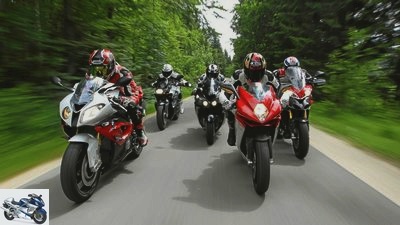
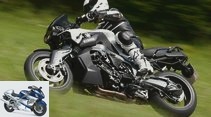
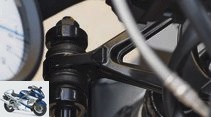
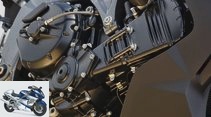
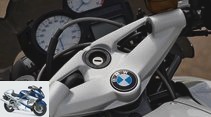
34 photos
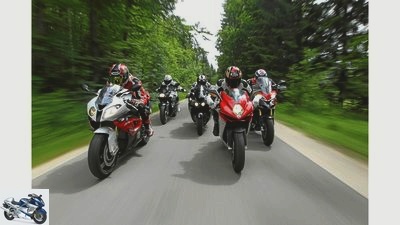
1/34
The strongest in their class: BMW K 1300 R, MV Agusta F3, Ducati Multistrada 1200 S, Kawasaki ZZR 1400, BMW S 1000 RR.
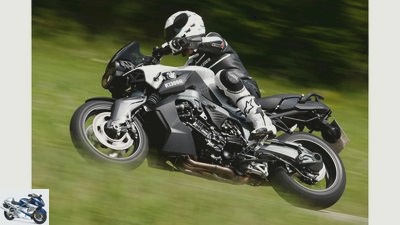
2/34
BMW K 1300 R: Laaaang, longer, K 1300 R. Thanks to the wide wheelbase, the naked bike shines with brutal braking power.
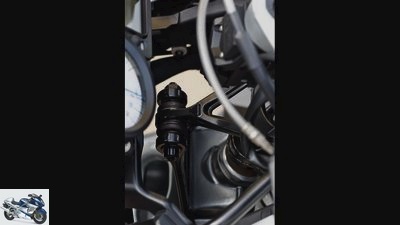
3/34
BMW K 1300 R: Not pretty, but functional: the Telelever in the front of the K 1300 R..
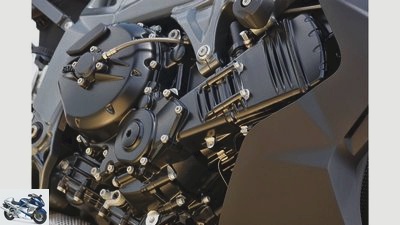
4/34
BMW K 1300 R: The 1300 big block lies undisguised under the frame.
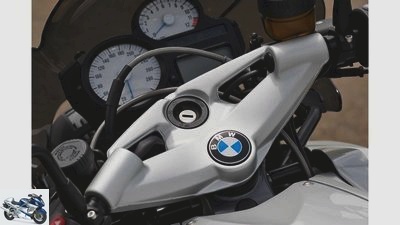
5/34
BMW K 1300 R: The bulky triple clamp of the BMW is reminiscent of the times before the fall of the Berlin Wall.
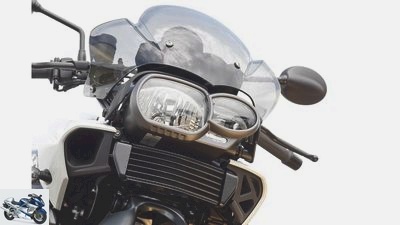
6/34
BMW K 1300 R: Mixture of insect and extraterrestrial: the front of the K 1300 R with integrated oil cooler.
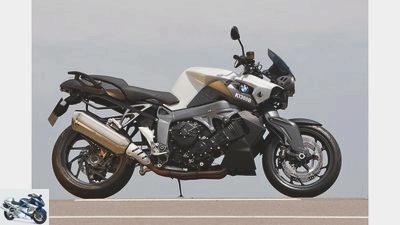
7/34
BMW K 1300 R: 5th place for the K 1300 R in a horsepower comparison.
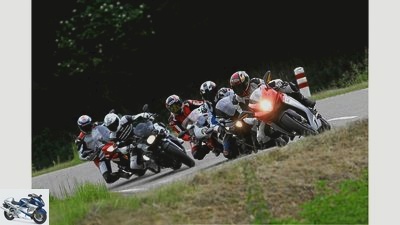
8/34
The strongest in their class: BMW K 1300 R, MV Agusta F3, Ducati Multistrada 1200 S, Kawasaki ZZR 1400, BMW S 1000 RR.
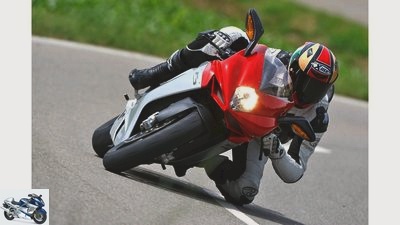
9/34
MV Agusta F3: Cuts through curves like an ax through the undergrowth: the F3 is extremely handy and stable.
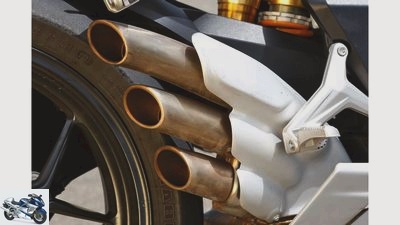
10/34
MV Agusta F3: So far without a muzzle requirement: The three horns bark like a Doberman.

11/34
MV Agusta F3: The automatic gearshift only works properly at five-digit speeds.
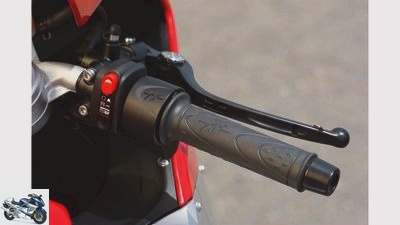
12/34
MV Agusta F3: Extremely smooth throttle. Pulling the brake lever causes brutal decelerations.
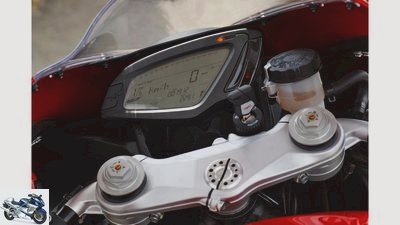
13/34
MV Agusta F3: Pretty fork bridge at the bottom, informative info display at the top, unfortunately difficult to read.
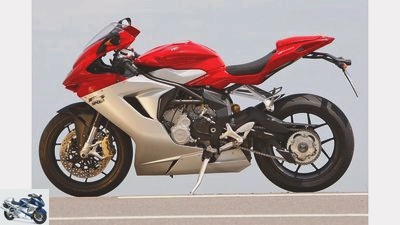
14/34
MV Agusta F3: In experienced hands, the F3 is a real weapon. Above all, their chassis is convincing. MV only has to get the engine tuning and vehicle balance under control – 4th place.
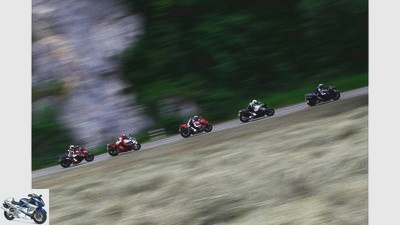
15/34
The strongest in their class: BMW K 1300 R, MV Agusta F3, Ducati Multistrada 1200 S, Kawasaki ZZR 1400, BMW S 1000 RR.
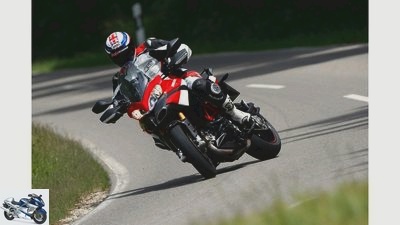
16/34
Ducati Multistrada 1200 S: Fun with a multistrudel: The Ducati is a fun toy that encourages braking drifts and wheelies.
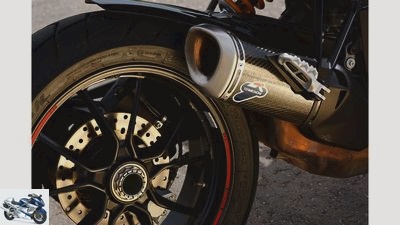
17/34
Ducati Multistrada 1200 S: The special edition “Pikes Peak” includes: Termignoni performance exhaust.
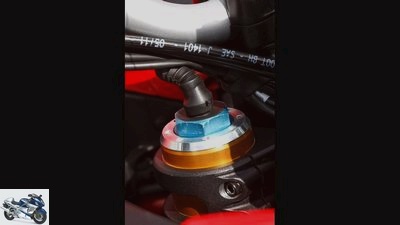
18/34
Ducati Multistrada 1200 S: With the Multistrada S version, rebound and compression can be set electronically.
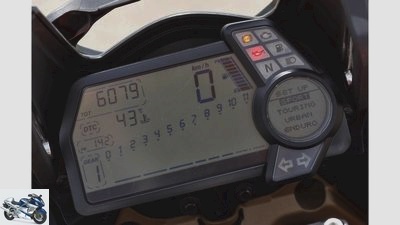
19/34
Ducati Multistrada 1200 S: Clearly arranged cockpit. Driving modes that are easy to select, but difficult to set in detail.
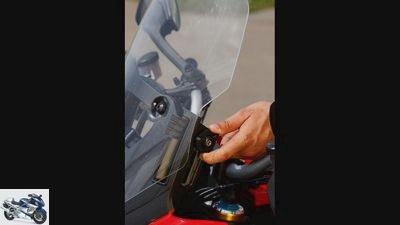
20/34
Ducati Multistrada 1200 S: Windshield: steplessly adjustable in six centimeters.
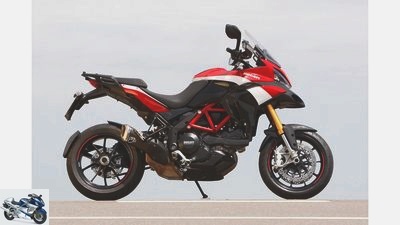
21/34
Ducati Multistrada 1200 S The twin all-rounder is a real joker with plenty of high-tech on board. He is scary fast on the road and also feels comfortable off-road – 3rd place.
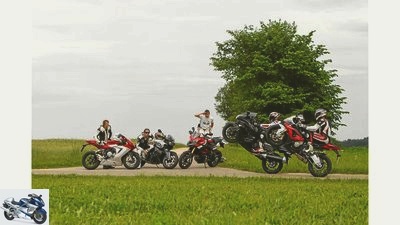
22/34
When the 200 hp bombers pass by, the rest of them look stupid.
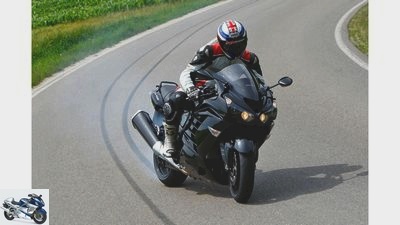
23/34
Kawasaki ZZR 1400: With traction control deactivated and a little practice, the ZZR 1400 paints wonderful lines in the landscape.
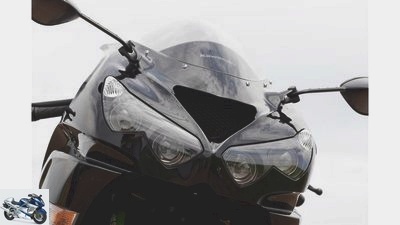
24/34
Kawasaki ZZR 1400: Muscular front with evil eye headlights and Ram Air inlet.
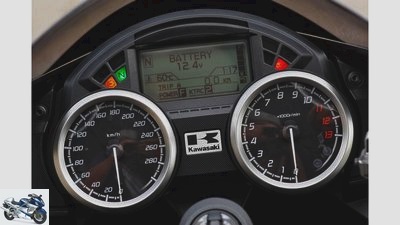
25/34
Kawasaki ZZR 1400: Powerful speed and rpm display, clear information display.
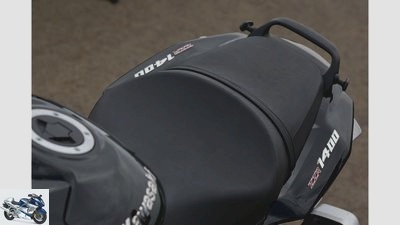
26/34
Kawasaki ZZR 1400: The ZZR 1400 bench: a two-person sofa with 300 km / h approval.
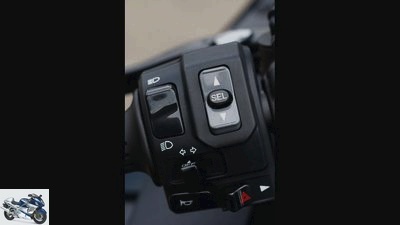
27/34
Kawasaki ZZR 1400: Gray switch: Control of the three-stage traction control and the two power modes.
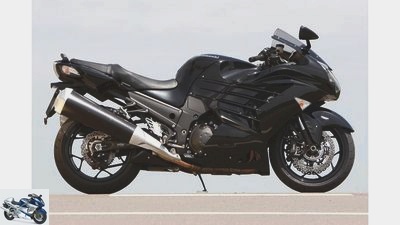
28/34
Kawasaki ZZR 1400: Kawasaki’s new super tourer hits like a bomb! The power plant can particularly show its strengths on the autobahn and on long country roads – 2nd place.
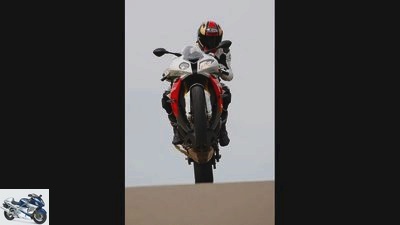
29/34
BMW S 1000 RR: Not a rare sight with 197 hp: Anyone who squeezes the BMW struggles with a rising front wheel.
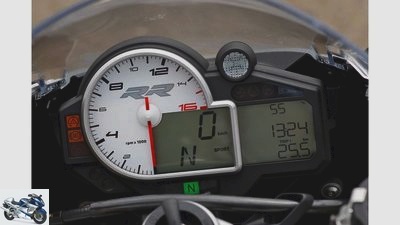
30/34
BMW S 1000 RR: This is what a racing cockpit should look like: the focus is on a large rev counter, speed and gear display.
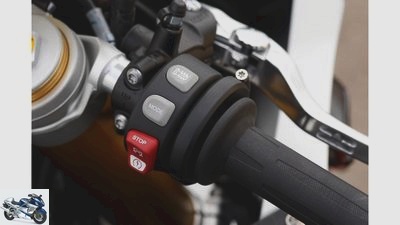
31/34
BMW S 1000 RR: Works great: The BMW is the only superbike with optional heated grips (197 euros).
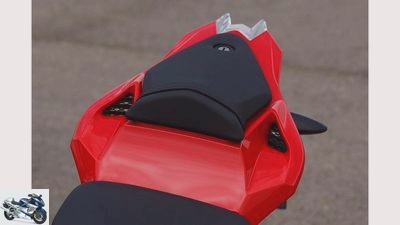
32/34
BMW S 1000 RR: The rear of the BMW was made slimmer for 2012 and got two air vents.

33/34
BMW S 1000 RR: The standard Continental Sport Attack 2 tires give the S 1000 RR razor-sharp handling.

34/34
BMW S 1000 RR: its chassis is sleek, its engine muscular, its sound nasty. The thousands from BMW invigorate all the senses. But she also drinks properly if you squeeze her – 1st place.
Comparison test: high-horsepower motorcycles
The most powerful motorcycles in their class
Content of
Faster, harder, better! They are the most powerful motorcycles in their class. And they all want only one thing: to shred the competition in the air. What will happen if these fighting cocks attack each other? PS tested it.
The strongest bikes in their class
Every existence has a purpose: trees clean the air, convertibles dissipate everyday stress and condom machines in night clubs prevent years of alimony. The five bikes in this review were also created for one purpose: to defend their class! They are the strongest and fastest of their kind. The newly released M.V Agusta F3 is the most potent 600cc athlete ever measured.
In the Superbike category, the BMW S 1000 RR with its almost 200 horses has won the horsepower crown for the third year in a row. In terms of performance, none of the Ducati Multistrada 1200 funbikes with its powerful two-cylinder engine can hold its own. The same applies to the BMW K 1300 R in the naked bike sector. And finally the currently most powerful production bike in the world, the Kawasaki ZZR 1400. With 206 HP on our dynamometer, the power tourer holds the absolute HP record. Well then let’s let the beasts loose on each other.
Kawasaki ZZR 1400: With traction control deactivated and a little practice, the ZZR 1400 paints wonderful lines in the landscape.
Kawa ZZR 1400
Shock for all Hayabusa fans! For over a decade, the big Suzuki was the most powerful production bike in the world. And now this: -Kawasaki’s freshly inflated ZZR 1400 lifts just under ten more with 206 hp, with almost the same weight. In fact, she takes just under a second from the old rival in the sprint to 200 km / h – downright devastating in this class.
And the driver feels that when he fully opens the throttle valve of the 1441 cubic big block. The newly launched Tourer pulverizes long straight stretches of the motorway even more impressively than its predecessor. And even cracks the current BMW S 1000 RR as the previous record holder in the sprint from zero to 200 km / h. The brutal propulsion is only captured by the electronic lock at 300 km / h. It’s a shame, because the ZZR glides over the asphalt at top speed like an ICE on rails and would easily master the last 500 tours to the red area.
The Japanese four-cylinder reacts to gas commands as smoothly as silk and develops its power most linearly compared to the entire test field. From 4000 rpm, just under 130 Nm of torque tear on the chain, enough to fly lazily over the country road in sixth gear. The afterburner rages between 7000 and 11000 rpm. Especially in the first three gears, the standard Bridgestone S20 tires braced themselves against the brutal torque in long curves. If you drive behind you will see deep black bars on the road and a slightly wagging rear end. The rear tire drifts away again and again and finds its way back on track as if by magic. The traction control, which is adjustable in three stages, works so sensitively that the driver hardly notices it. This gently prevents rear wheel slips and a rising front.
At the latest when chasing curves in the Black Forest, the Kawasaki reminds you of its 267 kilos. The pilot has to work with the load, take it by the horns and aim at corners early to get in and out cleanly. Gymnastics for construction workers! If you play according to these rules, you wag around quickly through serpentines. The ZZR 1400 angles surprisingly smoothly and can be braked deep into curves. Unfortunately, the hard pull-up moment of the front tire, which the driver has to fight against, bothers. Result: If he then releases the brake at the apex of the bend, the power tourer abruptly bends into a deeper lean angle.
Still balanced when walking at normal speed, the shock absorber of the Kawa in particular reaches its limit when gasping hard: It pumps and generates a kind of rocking chair effect, which remains controllable. If the rebound and compression stage is almost completely closed (see gear box), the load calms down a bit. But the shock absorber is clearly underdamped for sporty activities. With the fork, however, Kawa has achieved a good compromise. It offers sufficient cushioning reserves with good comfort at the same time. The latter only suffers from the sitting position, which puts a lot of weight on the wrists – in contrast, everything fits perfectly in the folded top speed mode. No other bike flies so relaxed towards the horizon at top speed. The ZZR 1400 is a rocket-powered touring sedan, it finally makes the controversial 300 km / h mark socially acceptable again. What an announcement! Unfortunately, acoustically far too unspectacular. The huge trumpet mufflers dampen the sound potential of the ZZR so much that the driver only receives wind noise.
BMW S 1000 RR: Not a rare sight with 197 hp: Anyone who squeezes the BMW struggles with a rising front wheel.
BMW S 1000 RR
Despite almost the same performance, the S 1000 RR drives a completely different race. From the very first meter, the rider feels what the most powerful superbike of all time was developed for: for world championships. Although the S 1000 RR has nine horsepower less than the ZZR 1400, it is almost 60 kilos lighter. That corresponds roughly to the weight of a petite passenger. Or you can compare it to a marathon runner who starts with or without a backpack. Therefore the Kawasaki is rather sedate, likes wide curves and long straights. The BMW, on the other hand, is very nimble, loves tight corners and literally begs for quick changes of direction. Zack, zack, zack and baaaaam – on the next straight in a power wheelie. The Bavarian accelerates like a slingshot, which also applies to braking in reverse. When kept in a species-appropriate manner, it does not allow the driver to breathe. Your acceleration and braking torque is so brutal that it brings water to your eyes. Even at top speed it tugs at the handlebars as badly as if it were about to skip the rev limiter. In a direct comparison of 200 HP, the ZZR 1400 is weight training, the S 1000 RR is martial arts!
The 1000-series engine runs much rougher than the Kawasaki’s big block, looks more aggressive and more sophisticated. Due to the top performance characteristics, the BMW appears subjectively stronger, but you would like more pressure up to 8000 rpm. Only beyond this mark does the performance fireworks really ignite. But the tone is right: it screams out of its funnel-shaped stump pot like a racing motorcycle and remains present even with earplugs. At 13,000 rpm, the sound concert even culminates in a beastly screeching that the limiter only stifles 1000 tours later.
Annoying: Between 3700 and 4500 rpm, nasty vibrations that tingle in the hands are annoying. Negligible on the racetrack, but in road traffic this speed range is often used. The smooth-running ZZR engine can only grin wearily at such bitches. The BMW traction control, revised for 2012, works a bit more sensitively than the Kawa system. And compared to the 2011 model, it finally creates trust on the road. In race mode, she paints solid black lines in corner exits, the pilot only notices a soft capture of the excess power and a wildly flashing yellow light in the cockpit. Wheelies are also grounded more gently than with the old model.
The standard Continental Sport Attack 2 tires, which literally bite into the asphalt, play a major role in the driving dynamics of the S 1000 RR. Warm-up time? Nothing! This tire-vehicle combination is a mind-expanding experience. Such handling in connection with the playful mastering of the maximum performance was previously only experienced by 600 athletes. All of this makes the S 1000 RR the most controllable racer in the test – unfortunately, the great fun with it begins beyond the StVO.
MV Agusta F3: Cuts through curves like an ax through the undergrowth: the F3 is extremely handy and stable.
MV Agusta F3
The F3 is also at war with the traffic regulations. The supersport newcomer, with 128 hp the strongest in its class, can be briefly summarized: razor-sharp handling, eardrum-killing sound, rock-hard seat cushion. The F3 is by far the most uncompromising bike in this test. And actually there is no rational reason to buy it apart from the optics – if it weren’t for your chassis! Hallelujah, the piece cuts through the Black Forest like an ax through the light undergrowth. In comparison, the S 1000 RR looks downright clumsy. The F3 falls as light as a feather in curves without appearing wobbly. Slopes can be selected and corrected as required. When the S 1000 RR pilot throws the brake anchor before entering the corner, the F3 pilot shoots past while crouching. It’s amazing how late and hard corners can be braked and how fed up the F3 is – regardless of the speed. This is almost revolutionary in series production and definitely the second consciousness-expanding experience in this test. In addition: Who would have thought that the F3 would hit the S 1000 RR so badly in terms of handiness, cornering stability and feedback, huh? There is almost glee! And the question of how you can combine such a cool chassis with such an engine set-up?
The three-cylinder pulls the arms impressively hard at a rated speed of 14600 rpm. In addition, the triplet barks like a hot Doberman. How did the beast get past the db muzzle requirement? But a steady running culture unfortunately only begins beyond 4000 rpm, below that the F3 spits and coughs like a cold two-stroke. At the simulated race start, the clutch grabs and with the same throttle position, the speed increases and decreases at will. Although the manufacturer has significantly improved the mapping since our first test (PS 4/2012), there is still no linear power development in relation to the throttle position.
The coordination problem is also clear in the following standard situation: applying gas at the apex of the curve at 8000 rpm. At first nothing happens, then suddenly there is full power on the rear wheel. Oops! Even the sticky Pirelli Diablo Rosso occasionally wedges out – at least when the traction control is switched off. The F3 is the first 600cc athlete to have one on board. However, the system works more coarsely than that of the S 1000 RR and ZZR 1400, and in some situations allows for violent slides – confidence-inspiring is different.
Another peculiarity of the F3: Its rear end becomes very light when braking and downshifting at the same time and tends to break out – despite the slipper clutch. Here the S 1000 RR seems much more balanced, braking drifts are only possible with persistent use of the rear brake. With a brisk pace, however, these can hardly be prevented with the F3. What makes the professional happy is dangerous for the normal driver. Nevertheless, MV Agusta is on the right track with the optimization of its F3, but the manufacturer must not pull the brake on development now. The road to the perfect motorcycle is still a long one. Potential buyers without much sporting experience should ask themselves: Does it have to be the strongest super sports car or does a Suzuki GSX-R 600 with less top performance, but all-round finer manners.
Ducati Multistrada 1200 S: Fun with a multistrudel: The Ducati is a fun toy that encourages braking drifts and wheelies.
Ducati Multistrada 1200 S.
The Multistrada 1200 is the most powerful fun bike on the planet thanks to its powerful two-cylinder engine from the Superbike 1198. As with the F3, her Italian blood is throbbing, but her parents were a little stricter in bringing up them. In other words, it adapts to every driver and masters almost every situation: hopping over hilly grass surfaces, drifting over coarse gravel or shooting over non-slip asphalt – it does almost everything and usually makes the driver smile. In direct comparison, the S 1000 RR is a sniper rifle, the Multistrada a confetti cannon. Which does not mean that the Ducati can be fooled. On fast stretches of country road, the Bavarian superbike has some difficulties to outrun the fun all-rounder. It’s crazy what can be done with this Italian all-purpose weapon.
Thanks to the wide handlebars, the Duc can be steered lightly through curves. The Ohlins chassis of the S variant lies comfortably on the road in sport mode and swallows bumps in the road with its long suspension travel: where the hard-tuned F3 almost kicks its driver out of the saddle, the Multistrada glides calmly away. The 1200 twin-cylinder delights with smooth running, linear power delivery and great responsiveness. Regardless of the gear and speed, throttle commands are implemented ultra-direct and in the required dosage. Compared to the rest of the test field, the engine feels the strongest pressure out of the lower speed range. When accelerating hard out of bends, the Italian likes to position her rear end sideways – even with traction control switched on (level 3, highest slip tolerance). Noticeable: if the driver drifts out of bends several times in a row in the wet, the electronics only stop drifting sideways on the fourth or fifth attempt. As if the slip control had to warm up first. Here the driver does not develop one hundred percent confidence, similar to the F3. The slipper clutch keeps the rear of the Multistrada nice and stable.
Anyone who usually only moves athletes has to get used to the seating position first: the pilot is downright nailed down, the freedom of movement is limited. And when chopping curves, the leg should be stretched out in the Supermoto style, otherwise it is better to order toe grinders in packs of hundreds. The footrests themselves, however, did not touch down.
BMW K 1300 R: Laaaang, longer, K 1300 R. Thanks to the wide wheelbase, the naked bike shines with brutal braking power.
BMW K 1300 R.
Since Suzuki’s B-King was phased out of the range last year, the K 1300 R with 173 hp is once again the most powerful naked bike in the world. However, it is already plowing through the landscape for the fourth year without any notable updates. Hello – where is the ambition of the other manufacturers? The latest naked bike descendants such as the Tuono V4R from Aprilia or the CB 1000 from Honda are far ahead in terms of handling, but far behind the BMW in terms of performance. And what does Suzuki actually do? How about: Just tear off the GSX-R 1000 fairing, drill out the engine and shoot the K 1300 R at the moon! That would be an announcement! Instead, everyone at BMW has their butter removed from their bread. In the end, it will turn out the way it should: Bayern bring the S 1000 RR as a naked fighter and the other manufacturers are looking down the drain again.
But back to our naked oldie: Instead of an ordinary suspension fork, a Telelever works at the front of the K 1300 R, which does everything differently than usual: The driver feels decoupled from the road, he hardly feels the front. Grip good? Bad grip? No idea! The system works, but it takes a lot of trust – similar to a marriage to Boris Becker. Advantage: the front does not dip when braking, it remains at vehicle height. In combination with the long wheelbase and the low wheelie inclination, this results in top braking values.
We remembered the engine of the BMW more lively from previous test drives, especially in the rev range. If you want to drive sportily, you have to choose low gears – up to 6000 rpm there is simply not enough lard. Beyond this mark, the 1300 turns like a racing engine and pushes powerfully.
The K 1300 R is pretty easy on the bend. It goes around the corner cleanly, but it needs a lot more emphasis than the Multistrada. And even the 15 kilo heavier ZZR 1400 lags only slightly behind in handling. In addition, in the middle of the three suspension modes (normal mode), the shock absorber forwards too many blows to the driver. The hard gear changes also bring unrest to the load. The gasoline vapor has evaporated, the brake dust has subsided, and the mind has calmed down.
What do we know after 3000 test kilometers and 250 liters of fuel with the most powerful bikes in the various classes? That you can empty tanks and rub tires off incredibly quickly with 200 hp. That with a good half of this power you may be faster if the chassis fits. That super athlete drivers can grit their teeth on the Funbike Multistrada 1200 S. And that everyone can find their bike with the right maximum performance. Your PS grenade is waiting out there, new or used.
archive
Power of the horsepower giants.
Strong, stronger, ZZR 1400. What looks gigantic on the performance diagram, also drives like this: From 4000 rpm, the Kawa burns down everything else. Its torque peak is applied early, it unfolds its power nicely and homogeneously, so it looks downright friendly. The maximum torque of the S 1000 RR comes much later. It needs a lot of speed to get going. But from 8000 rpm it literally explodes, subjectively even feels stronger than the ZZR 1400. Due to the small displacement and its design for maximum performance, the F3 is mostly geared towards speed. It only really starts shooting in the five-digit speed range. The Multistrada is a real torque hammer and the K 1300 R unfortunately feels more tired in the lower rev range than the diagram suggests.
| Acceleration** | Draft** | Top speed * | ||||
| 0-100 km / h | 0-150 km / h | 0-200 km / h | 50-100 km / h | 100-150 km / h | ||
| BMW K 1300 R. | 2.9 s | 4.9 s | 7.9 s | 4.0 s | 4.0 s | 270 km / h |
| BMW S 1000 RR | 3.2 s | 5.1 s | 7.2 s | 4.3 s | 4.0 s | 299 km / h |
| Ducati Multistrada 1200 S. | 3.3 s | 5.8 s | 10.1 s | 5.1 s | 5.4 s | 245 km / h |
| Kawasaki ZZR 1400 | 2.9 s | 4.7 s | 7.0 s | 4.9 s | 3.8 s | 298 km / h |
| MV agusta F3 | 3.6 s | 6.0 s | 9.8 s | 5.4 s | 5.4 s | 260 km / h |
* Manufacturer information
** PS readings
BMW K 1300 R.
BMW K 1300 R..
drive
Four-cylinder in-line engine, 4 valves / cylinder, 127 kW (173 HP) at 9250 / min *, 140 Nm at 8250 / min *, 1293 cm³, bore / stroke: 80.0 / 64.3 mm, compression ratio: 13.0 : 1, ignition / injection system, 46 mm throttle valves, hydraulically operated multi-disc oil bath clutch, six-speed gearbox, G-Kat, cardan
landing gear
Light alloy bridge frame, steering head angle: 60.4 degrees, caster: 104.4 mm, wheelbase: 1585 mm, trailing arm guided telescopic fork, Ø fork inner tube: 47 mm, electrically adjustable in spring base, rebound and compression. Central spring strut with deflection, electrically adjustable in spring base, rebound and compression. Suspension travel front / rear: 115/135 mm
Wheels and brakes
Cast light alloy wheels, 3.50 x 17 / 6.00 x 17, front tires: 120/70 ZR 17, rear: 190/55 ZR 17, test tires: Metzeler Sportec M3, 320 mm double disc brakes with four-piston fixed calipers at the front, 265 mm Single disc with two-piston floating caliper at the rear
measurements and weight
Length / width / height: 2228/856/1095 mm, seat / handlebar height: 820/1000 mm, handlebar width: 715 mm, 252 kg fully fueled, v./h .: 48.9 / 51.1% rear wheel power in the last gear 119 kW (161 PS) at 243 km / h
Consumption fuel type
Super unleaded. Average test consumption: 7.3 liters / 100 km, tank capacity 19.0 liters, range: 260 km
Base price
13900 Euro (plus Nk, without ESA, ABS, automatic switch etc..
PS judgment
BMW K 1300 R The naked bike oldie falls far behind in this group test. He steers heavily and his 1300 four-cylinder lacks some pressure around the bottom. But she can brake really well – 5th place.
BMW S 1000 RR
BMW S 1000 RR.
drive
Four-cylinder in-line engine, 4 valves / cylinder, 142 kW (193 hp) at 13,000 / min *, 112 Nm at 9750 / min *, 999 cm³, bore / stroke: 80.0 / 49.7 mm, compression ratio: 13, 0: 1, ignition / injection system, 48 mm throttle valves, mechanically operated multi-disc oil bath anti-hopping clutch, six-speed gearbox, G-Kat, chain, traction control
landing gear
Light alloy bridge frame, steering head angle: 66.0 degrees, caster: 99 mm, wheelbase: 1423 mm, upside-down fork, Ø fork inner tube: 46 mm, adjustable in spring base, rebound and compression. Central spring strut with deflection, adjustable in spring base, rebound and compression (high / low). Suspension travel front / rear: 120/130 mm
Wheels and brakes
Light alloy cast wheels, 3.50 x 17 / 6.00 x 17, front tires: 120/70 ZR 17, rear: 190/55 ZR 17, first tires: Continental Sport Attack 2, 320 mm double disc brakes with four-piston fixed calipers at the front, 220 mm -Single disc with single-piston floating caliper at the rear, ABS
measurements and weight
Length / width / height: 2020/800/1090 mm, seat / handlebar height: 805/855 mm, handlebar width: 640 mm, 208.5 kg fully fueled, v./h .: 51.5 / 48.5% rear wheel performance in last gear 137 kW (186 PS) at 273 km / h
consumption
Fuel type: Super unleaded. Average test consumption: 8.2 liters / 100 km, tank capacity 17.5 liters, range: 213 km
Base price
16,100 euros (plus ancillary costs, ABS + DTC 1230 euros, automatic switch 364 euros, heated grips 197 euros)
PS judgment
BMW S 1000 RR Its chassis is sleek, its engine muscular, its sound nasty. The thousands from BMW invigorate all the senses. But she also drinks properly if you squeeze her – 1st place.
Ducati Multistrada S Pikes Peak
Ducati Multistrada S Pikes Peak.
drive
Two-cylinder 90-degree V-engine, 4 valves / cylinder, 109 kW (148 PS) at 9250 / min *, 119 Nm at 7500 / min *, 1198 cm³, bore / stroke: 106.0 / 67.9 mm , Compression ratio: 11.5: 1, ignition / injection system, 64 mm throttle valves, hydraulically operated multi-plate oil bath clutch, six-speed gearbox, G-Kat, chain
landing gear
Steel tubular frame, steering head angle: 65.0 degrees, caster: 104 mm, wheelbase: 1530 mm, upside-down fork, Ø fork inner tube: 48 mm, electrically adjustable in spring base, rebound and compression stage. Central spring strut with deflection, electrically adjustable in spring base, rebound and compression. Suspension travel front / rear: 170/170 mm
Wheels and brakes
Forged light alloy wheels, 3.50 x 17 / 6.00 x 17, front tires: 120/70 ZR 17, rear: 190/55 ZR 17, test tires: Pirelli Scorpion Trail, 320 mm double disc brakes with radially screwed four-piston fixed calipers at the front, 245- mm single disc with two-piston fixed caliper at the rear
measurements and weight
Length / width / height: 2200/910/1400 mm, seat / handlebar height: 840/1120 mm, handlebar width: 830 mm, 234 kg with a full tank, v./h .: 49.7 / 50.3% rear wheel power in the last gear 99 kW (135 PS) at 240 km / h
consumption
Fuel type: Super unleaded. Average test consumption: 7.2 liters / 100 km, tank capacity 20.0 liters, range: 278 km
Base price
20,990 euros (plus ancillary costs), Pikes Peak Edition with carbon attachments and Termignoni exhaust
PS judgment
Ducati Multistrada 1200 S The twin all-rounder is a real joker with plenty of high-tech on board. He is scary fast on the road and also feels comfortable off-road – 3rd place.
Kawasaki ZZR 1400
Kawasaki ZZR 1400.
drive
Four-cylinder in-line engine, 4 valves / cylinder, 147 kW (200 HP) at 10,000 rpm *, 163 Nm at 7500 rpm *, 1441 cm3, bore / stroke: 84.0 / 65.0 mm, compression: 12, 3: 1, ignition / injection system, 44 mm throttle valves, hydraulically operated multi-disc oil bath anti-hopping clutch, six-speed gearbox, G-Kat, SLS
landing gear
Light alloy monocoque frame, steering head angle: 67 degrees, caster: 93 mm, wheelbase: 1480 mm, upside-down fork, Ø fork inner tube: 43 mm, adjustable spring base, rebound and compression stage. Central spring strut with deflection, adjustable in spring base, rebound and compression. Spring travel from / h .: 117/124 mm
Wheels and brakes
Cast light alloy wheels, 3.50 x 17 / 6.00 x 17, front tires: 120/70 ZR 17, rear: 190/50 ZR 17, Bridgestone S 20 “E” tires, 310 mm double disc brakes with radially screwed four-piston fixed calipers at the front, 250 mm single disc with two-piston fixed caliper at the rear
measurements and weight
Length / width / height: 2160/880/1170 mm, seat / handlebar height: 800/900 mm, handlebar width: 685 mm, 267 kg with a full tank, v./h .: 49.8 / 50.2% rear wheel power in the last gear 142 kW (193 hp) at 280 km / h
consumption
Fuel type: Super unleaded. Average test consumption: 7.2 liters / 100 km, tank capacity 22 liters, range: 305 km
Base price
15595 Euro (plus ancillary costs)
PS judgment
Kawasaki ZZR 1400 Kawasaki’s new super tourer hits like a bomb! The power plant can particularly show its strengths on the autobahn and on long country roads – 2nd place.
MV Agusta F 3
MV Agusta F 3.
drive
Three-cylinder in-line engine, 4 valves / cylinder, 94 kW (128 hp) at 14 400 rpm *, 71 Nm at 10 600 rpm *, 675 cm³, bore / stroke: 79.0 / 45.9 mm, compression ratio: 13 , 0: 1, ignition / injection system, 50 mm throttle valves, hydraulically operated multi-disc oil bath anti-hopping clutch, six-speed gearbox, chain, G-Kat, traction control
landing gear
Steel tubular space frame, steering head angle: 66.0 degrees, caster: 99 mm, wheelbase: 1380 mm, upside-down fork, Ø fork inner tube: 43 mm, adjustable spring base, rebound and compression stage. Central spring strut with deflection, adjustable in spring base, rebound and compression. Suspension travel front / rear: 125/123 mm
Wheels and brakes
Cast light alloy wheels, 3.50 x 17 / 5.50 x 17, front tires: 120/70 ZR 17, rear: 180/55 ZR 17, first tires: Pirelli Diablo Rosso Corsa, 320 mm double disc brakes with radially attached four-piston fixed calipers at the front , 220 mm single disc with two-piston fixed caliper at the rear
measurements and weight
Length / width / height: 2070/760/1100 mm, seat / handlebar height: 810/845 mm, handlebar width: 690 mm, 193 kg with a full tank, v./h .: 51.7 / 48.3% rear wheel power in the last gear 86 kW (116 PS) at 248 km / h
consumption
Fuel type: Super unleaded. Average test consumption: 6.5 liters / 100 km, tank capacity 16 liters, range: 246 km
Base price
11990 Euro (plus ancillary costs)
PS judgment
MV Agusta F3 In experienced hands the F3 is a real weapon. Above all, their chassis is convincing. MV only needs to get the engine tuning and vehicle balance under control – 4th place.
Related articles
-
BMW, Ducati, Suzuki and Triumph super sports cars in a comparison test
29 photos 1/29 Triumph Daytona 675, Ducati 848 Evo Corse SE, BMW S 1000 RR, Suzuki GSX-R 750. Different bikes – different cubic…
-
Comparison test: Ducati 1198 S against Ducati Multistrada 1200 S
Jahn Comparison test: Ducati 1198 S against Ducati Multistrada 1200 S Ducati 1198 S versus Ducati Multistrada 1200 S Content of One brand, one engine,…
-
Comparison test of the 1000 super sports car, part 1
Jahn Comparison test of the 1000 super sports car, part 1 The full program Lean, strong, ready for attack, the Suzuki GSX-R 1000 completes the field of…
-
BMW, Honda, Kawasaki, Suzuki and Yamaha super sports cars in a comparison test
Judd 26th photos Nicolaou 1/26 In the supersports comparison test: Kawasaki ZX-10R, BMW S 1000 RR, Suzuki GSX-R 1000, Honda Fireblade C-ABS and Yamaha…
-
Comparison test: Ducati Diavel, Suzuki B-King and Yamaha Vmax
Jahn Comparison test: Power Bikes 2011 Ducati Diavel, Suzuki B-King and Yamaha Vmax Content of Big appearance, powerful sound waves, pressure from all…
-
Comparison test: super sports cars under 1000 cubic meters from MV Agusta, Ducati and Kawasaki
Jahn 46 photos Jahn 1/46 Kawasaki ZX-6R 636 Jahn 2/46 But the Evo is not alone in this. All three bikes rock the ring during the test. Jahn 3/46 … and…
-
Comparison test: Superbikes 2012
32 photos 1/32 Yamaha YZF-R1, MV Agusta F4 RR, Kawasaki ZX 10-R, BMW S 1000 RR and Honda Fireblade C-ABS in the supersport…
-
Comparison test: power naked bikes on the racetrack
Comparison test: naked bikes on the racetrack Country road fighter on the racetrack Content of It has to be extreme – that shows what is…
-
Comparison test of naked bikes
Naked bike comparison test 2011: Ducati, Kawasaki and Triumph The triumph of the new Speed Triple Content of Triumph strikes back. After…
-
Comparison test: MV Agusta Brutale 1090 RR and Ducati Streetfighter S
fact Comparison test: Italian naked bikes, Ducati Streetfighter S, MV Agusta Brutale 1090 RR MV Agusta Brutale 1090 RR and Ducati Streetfighter S Content…